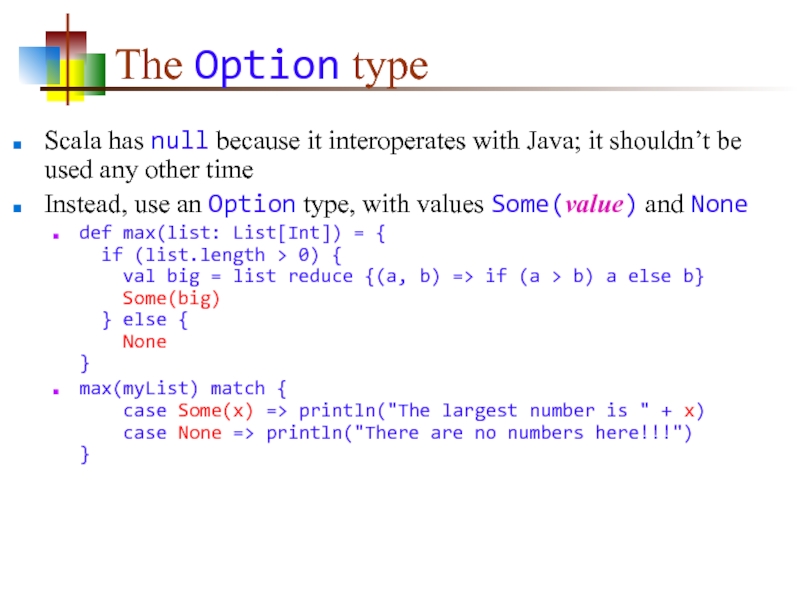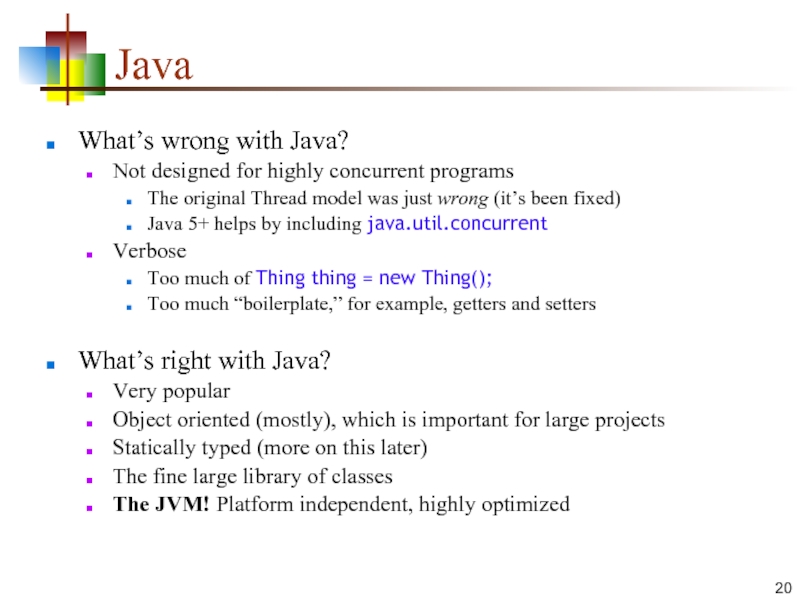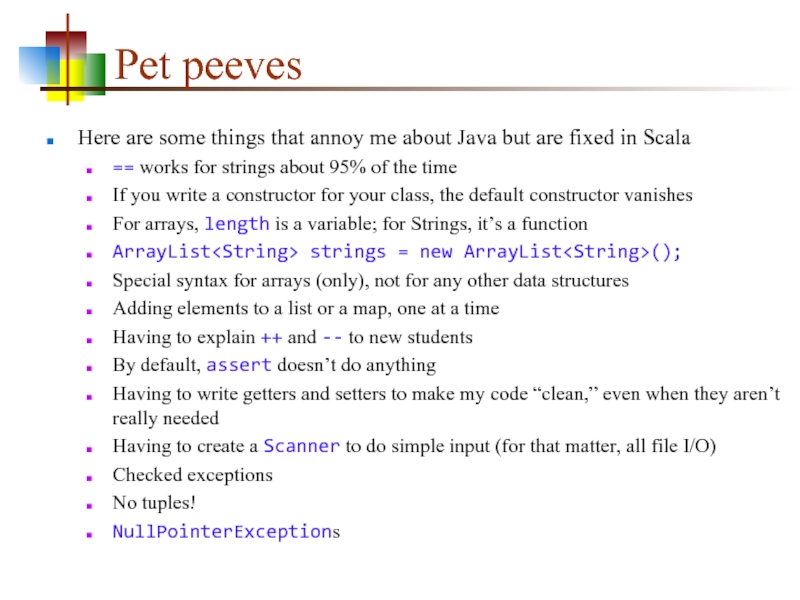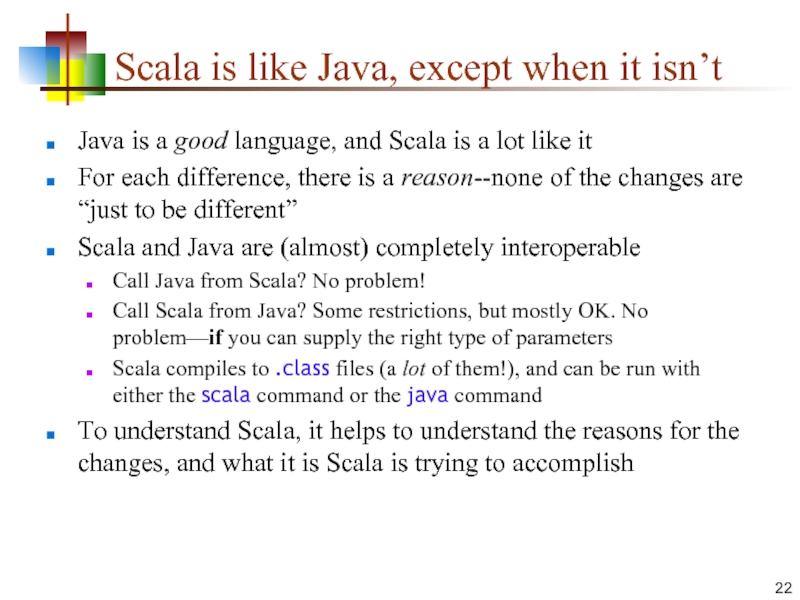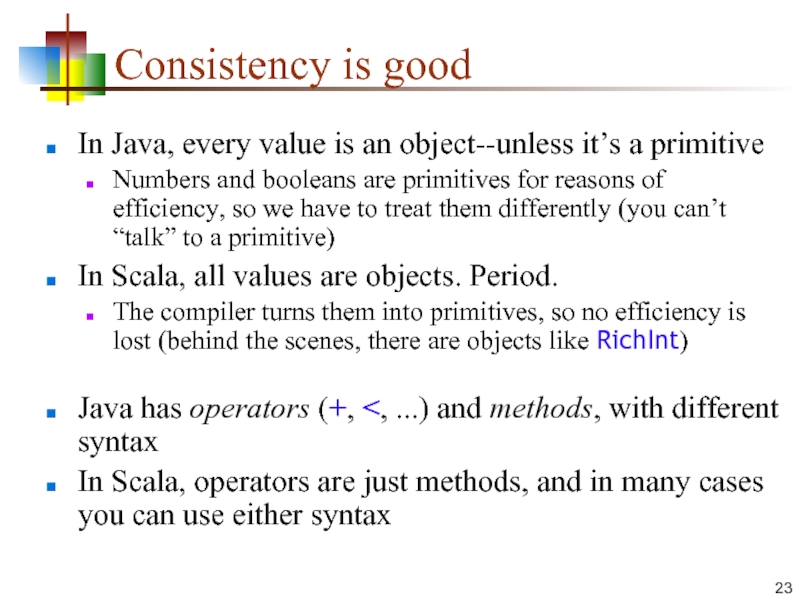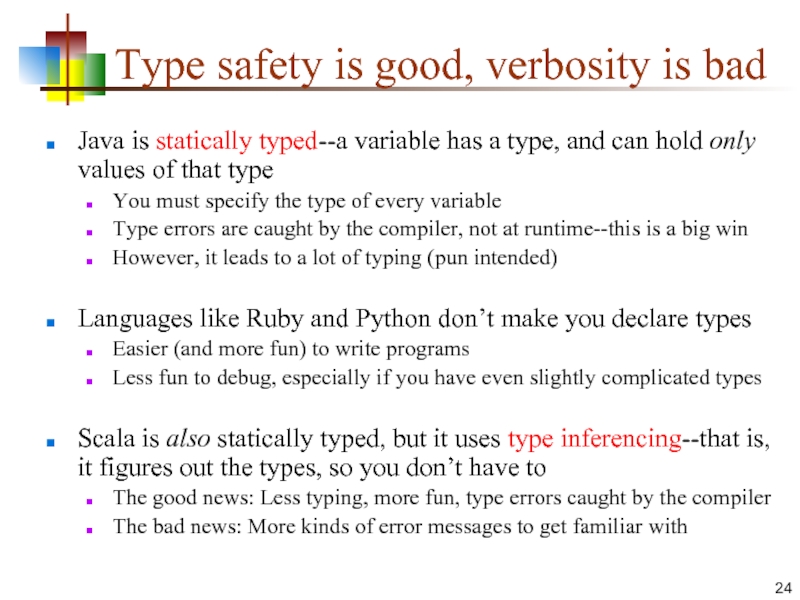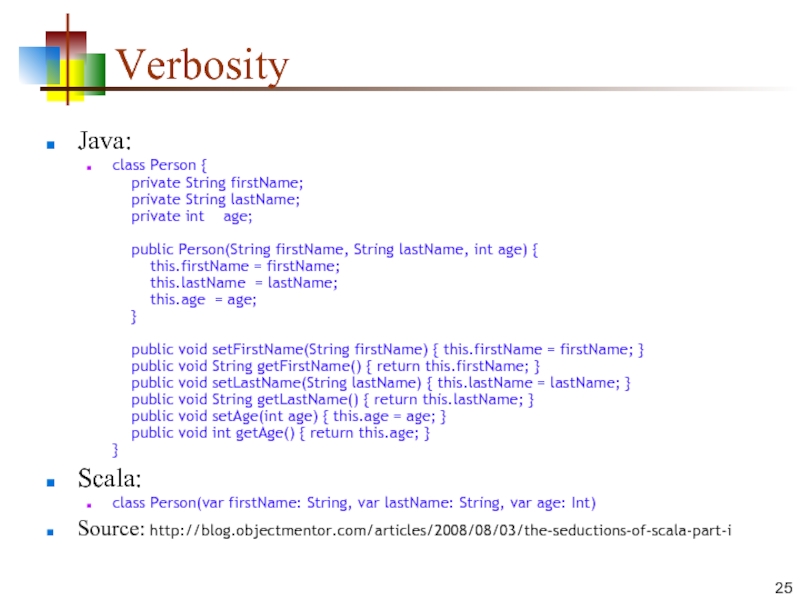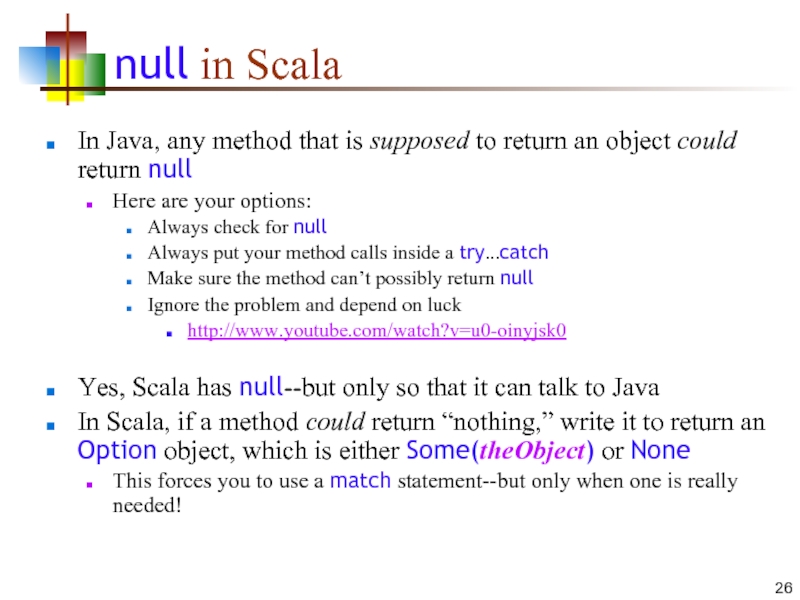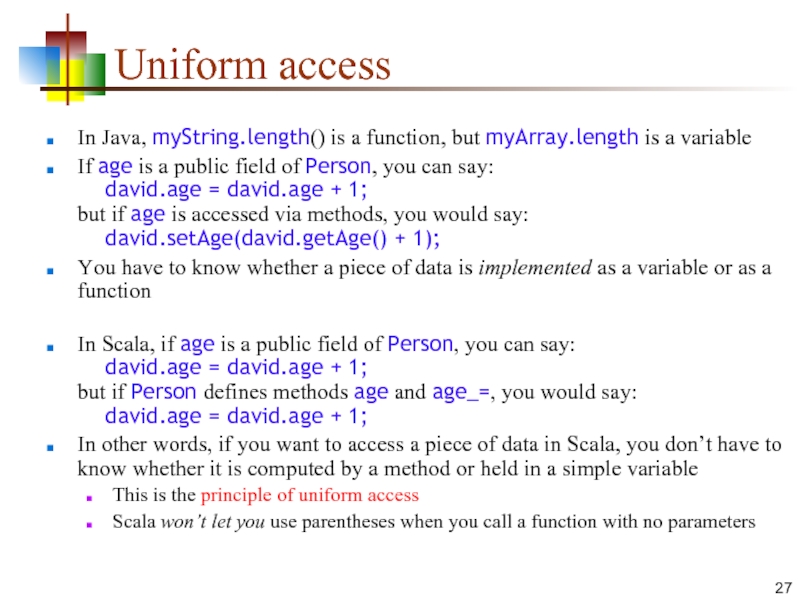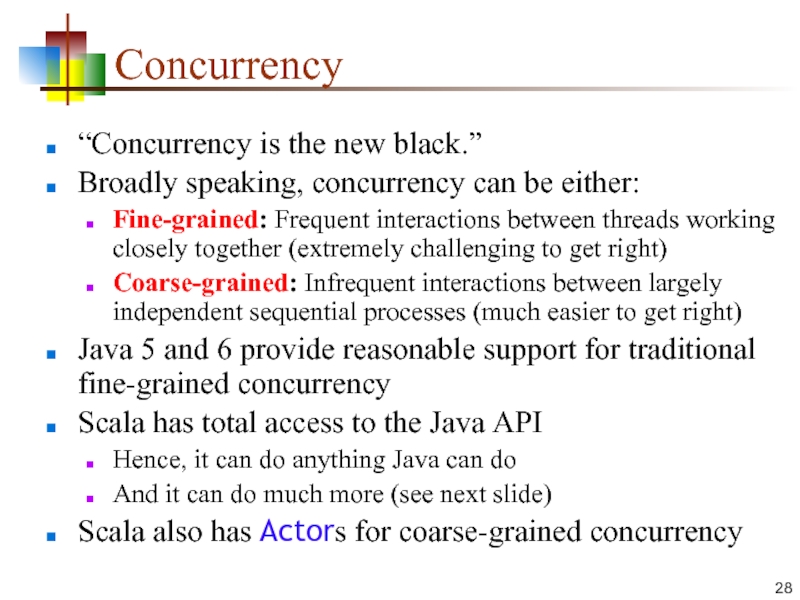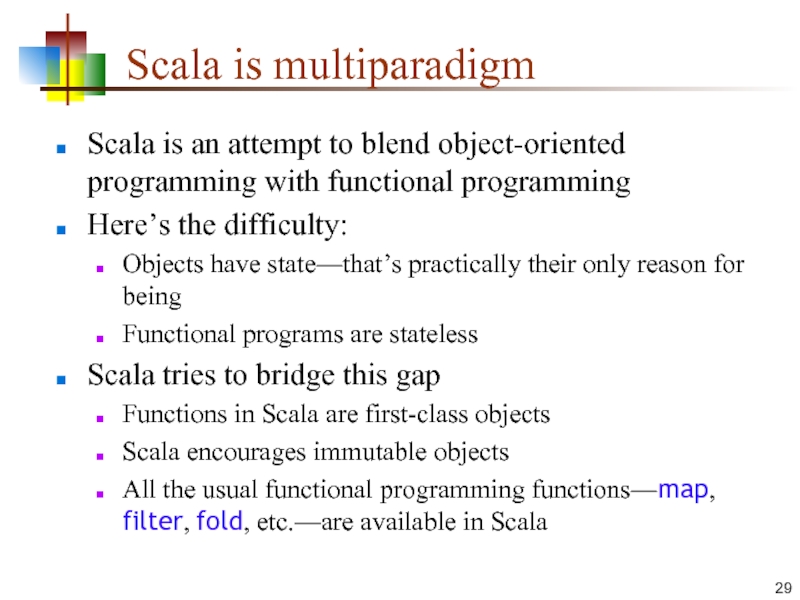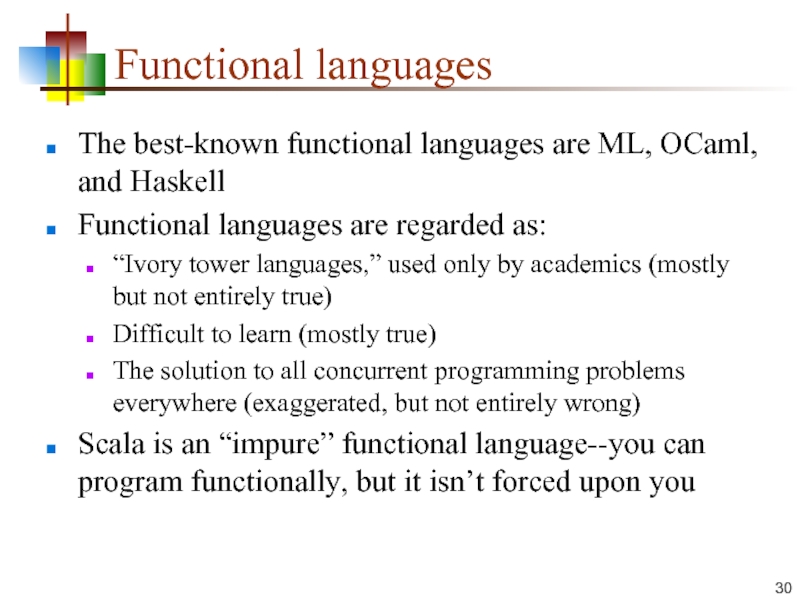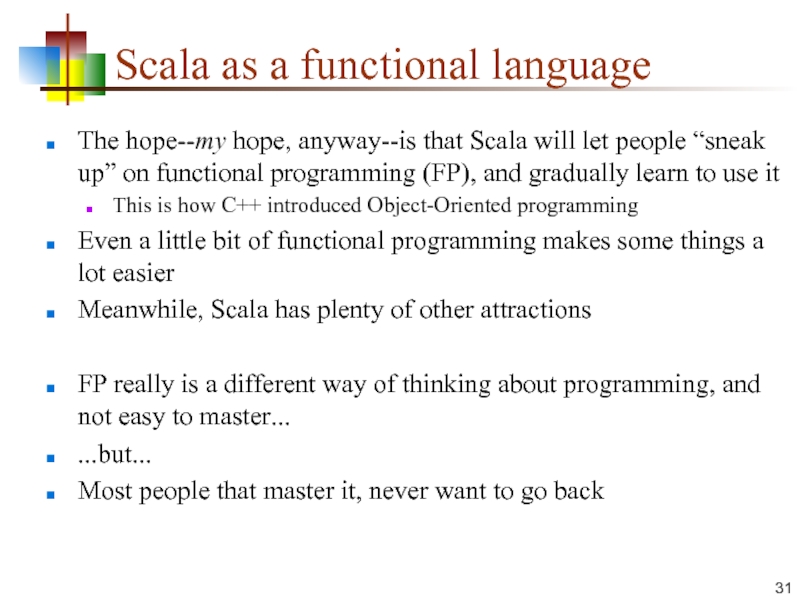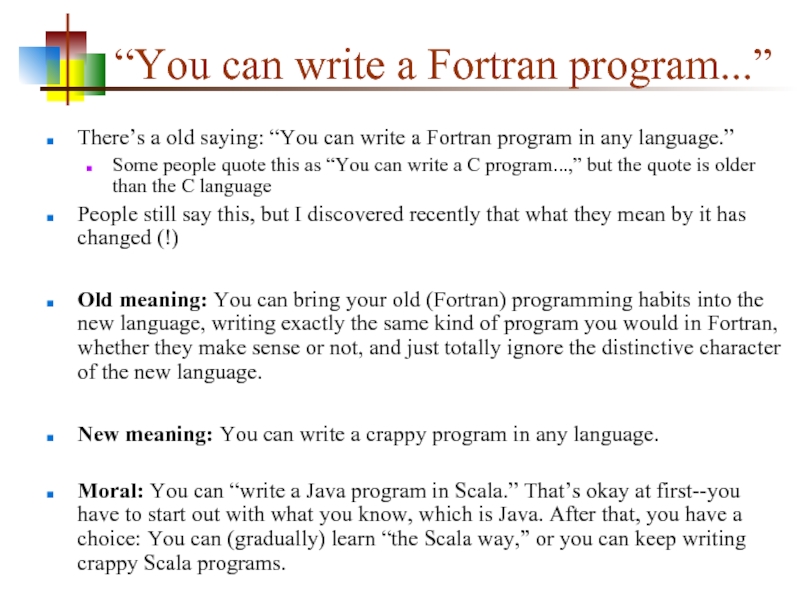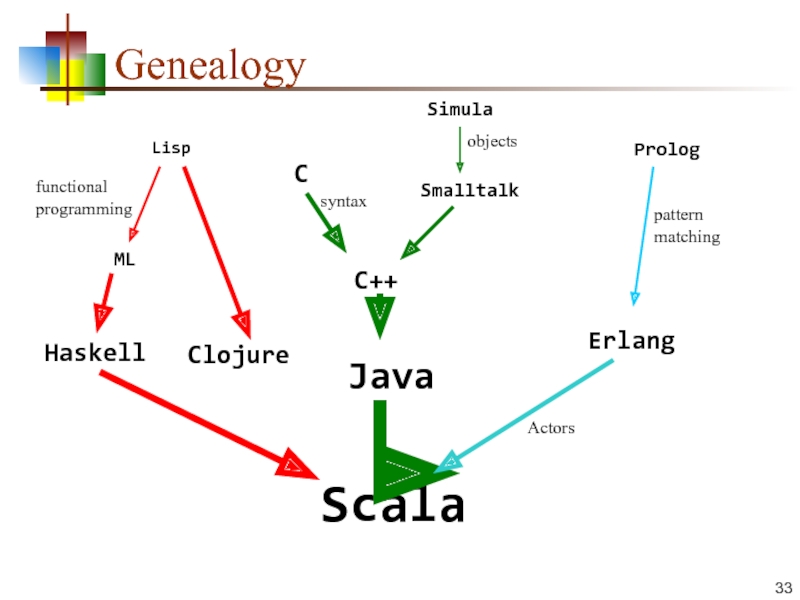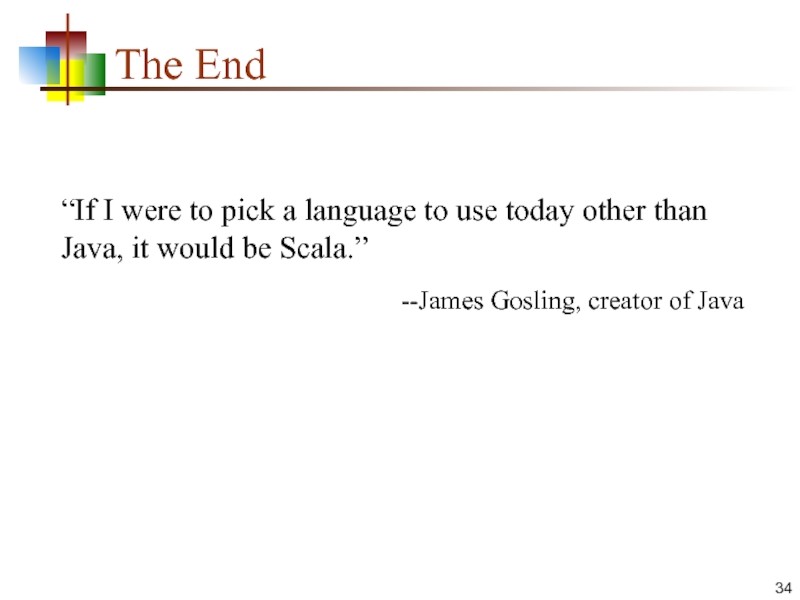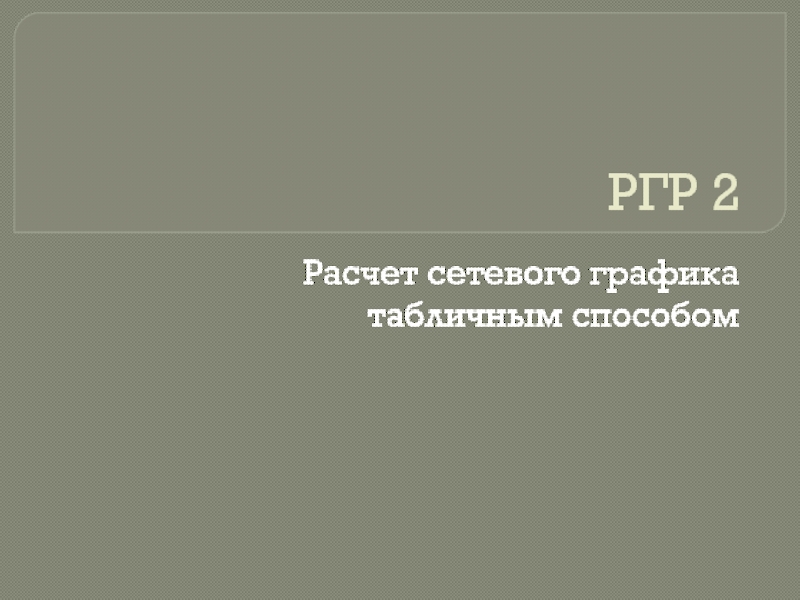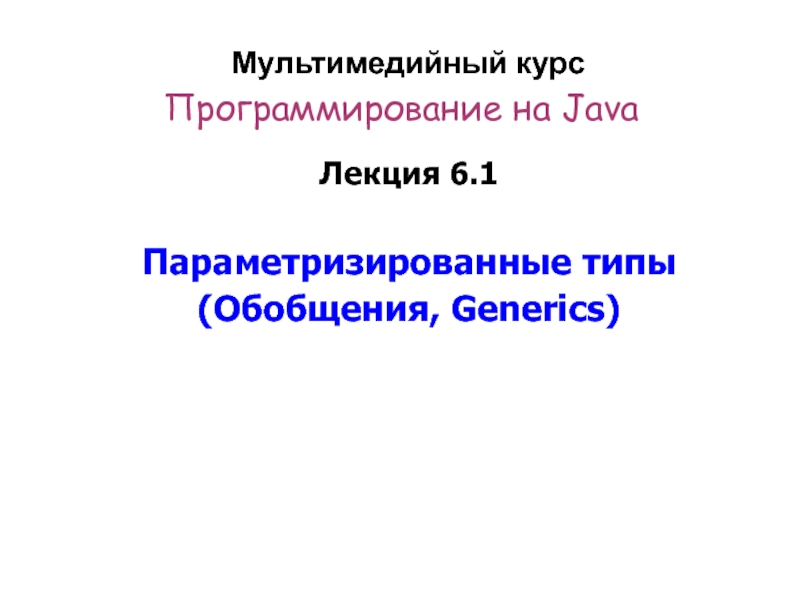- Главная
- Разное
- Дизайн
- Бизнес и предпринимательство
- Аналитика
- Образование
- Развлечения
- Красота и здоровье
- Финансы
- Государство
- Путешествия
- Спорт
- Недвижимость
- Армия
- Графика
- Культурология
- Еда и кулинария
- Лингвистика
- Английский язык
- Астрономия
- Алгебра
- Биология
- География
- Детские презентации
- Информатика
- История
- Литература
- Маркетинг
- Математика
- Медицина
- Менеджмент
- Музыка
- МХК
- Немецкий язык
- ОБЖ
- Обществознание
- Окружающий мир
- Педагогика
- Русский язык
- Технология
- Физика
- Философия
- Химия
- Шаблоны, картинки для презентаций
- Экология
- Экономика
- Юриспруденция
Scala. Java to Scala презентация
Содержание
- 1. Scala. Java to Scala
- 2. Types Primitives char byte short int long
- 3. Type declarations int x; final int Y
- 4. “Statements” Scala’s “statements” should really be called
- 5. Constructors class Point { private
- 6. Getters Java: Make the instance variables private,
- 7. Both getters and setters Java: Write as
- 8. Auxiliary constructors Java: Can have multiple constructors,
- 9. Defining equality for objects @Override public boolean
- 10. Case classes in Scala A case class
- 11. Input and output Scanner scanner = new
- 12. Singleton objects class Earth {
- 13. Operators in Scala Scala has the same
- 14. Familiar statement types These are the same
- 15. The for comprehension Scala’s for is much
- 16. for…yield for returns Unit, but for…yield returns
- 17. Explicit pattern matching Explicit pattern matching is
- 18. Pattern matching Pattern matching on literal values:
- 19. The Option type Scala has null because
- 20. Java What’s wrong with Java? Not designed
- 21. Pet peeves Here are some things that
- 22. Scala is like Java, except when it
- 23. Consistency is good In Java, every value
- 24. Type safety is good, verbosity is bad
- 25. Verbosity Java: class Person {
- 26. null in Scala In Java, any method
- 27. Uniform access In Java, myString.length() is a
- 28. Concurrency “Concurrency is the new black.” Broadly
- 29. Scala is multiparadigm Scala is an attempt
- 30. Functional languages The best-known functional languages are
- 31. Scala as a functional language The hope--my
- 32. “You can write a Fortran program...” There’s
- 33. Genealogy Scala Java C C++ Simula Smalltalk
- 34. The End “If I were to pick
Слайд 2Types
Primitives
char
byte
short
int
long
float
double
boolean
Objects
String
… and many more …
Objects
Char
Byte
Short
Int
Long
Float
Double
Boolean
String
Function
… and many more …
Scala doesn't have
Behind the scenes, objects are converted to primitives as necessary, so there is no loss in efficiency
Слайд 3Type declarations
int x;
final int Y = 0;
int[] langs = {"C++", "Java",
Set
var x = 0
The keyword var introduces a mutable variable
Variable declarations must include an initial value
The type of variable is inferred from the initial value
val y = 0
The keyword val introduces an immutable variable
val langs = Array("C++", "Java", "Scala")
val langs = Set("C++", "Java", "Scala")
Слайд 4“Statements”
Scala’s “statements” should really be called “expressions,” because every statement has
The value of many statements, for example the while loop, is ()
() is a value of type Unit
() is the only value of type Unit
() basically means “Nothing to see here. Move along.”
The value of a if or match statement is the last value computed
The value of a block, {…}, is the last value computed in the block
A statement is ended by the end of the line (not with a semicolon) unless it is obviously incomplete, or if the next line cannot begin a valid statement
For example, x = 3 * (2 * y + is obviously incomplete
Because Scala lets you leave out a lot of unnecessary punctuation, sometimes a line that you think is complete really isn’t complete (or vice versa)
You can end statements with semicolons, but that’s not good Scala practice
Слайд 5Constructors
class Point {
private double x;
private double y;
class Point(x: Double, y: Double) {
...
}
Unqualified parameters are effectively private final instance variables
Слайд 6Getters
Java: Make the instance variables private, and write getter methods
class Point
Point p = new Point(3.6, 4.7); System.out.println(p.getX());
Scala: Replace the primary constructor line with
class Point(val x: Double, val y: Double) {...}
val p = new Point(3.6, 4.7)
println(p.x)
Слайд 7Both getters and setters
Java: Write as methods
public double getX() {
p.setX(2 * p.getX());
Scala: Replace the primary constructor line with
class Point(var x: Double, var y: Double)
p.x = 2 * p.x
Слайд 8Auxiliary constructors
Java: Can have multiple constructors, which may or may not
public Point(double x, double y) {...} public Point() { this(0, 0); }
class Point(x: Double, y: Double) {...}
def this() {
this(0, 0)
}
Every auxiliary constructor must refer to a previously defined constructor
Слайд 9Defining equality for objects
@Override
public boolean equals(Object other) {
if (other
final override def equals(Other: Any) = {
val that = other.asInstanceOf[Point]
if (that == null) false
else this.x == that.x && this.y == that.y
OR:
case class Point(x: Double, y: Double) {...}
Слайд 10Case classes in Scala
A case class is just like a regular
The methods equals, hashCode, toString, and copy are automatically defined for you, based on the parameters to the primary constructor
Each of the constructor parameters becomes a var (so you have getters and setters)
An apply method is created—this lets you omit the word new when creating new objects
An unapply method is created, which allows you to pattern match on your objects
Слайд 11Input and output
Scanner scanner = new Scanner(System.in);
System.out.println("What is your name? ");
String
System.out.println("Hello, " + name);
val name = readLine("What is your name? ")
println("Hello, " + name)
Слайд 12Singleton objects
class Earth {
final double diameter = 7926.3352;
object Earth {
val diameter = 7926.3352
}
Слайд 13Operators in Scala
Scala has the same arithmetic and logical operators as
++ and -- have been removed
test ? iftrue : iffalse has been replaced by if (test) iftrue else iffalse which is an expression
Слайд 14Familiar statement types
These are the same as in Java, but have
variable = expression // also +=, *=, etc.
while (condition) { statements }
do { statements } while (condition)
These are the same as in Java, but may have a useful value:
{ statements }
The value of the block is the last value computed in it
if (condition) { statements } else { statements }
The value is the value of whichever block is chosen
If the value is to be used, both blocks should have the same type, otherwise the type of the result is the “least upper bound” of the two types
if (condition) { statements }
The value is the value of the last statement executed, but its type is Any – if you want a value, you really should use an else
As in Java, braces around a single statement may be omitted
Слайд 15The for comprehension
Scala’s for is much more powerful than Java’s for
Consequently,
We will just cover some simple cases here
for (i <- 1 to 10) { println(i) }
Prints the numbers 1 through 10
for (i <- 1 until 10) { println(i) }
Prints the numbers 1 through 9
for (x <- 0 until myArray.length) { println(myArray(x)) }
Prints all the values in myArray
for (x <- myArray) { println(x) }
Prints all the values in myArray
for (x <- myArray if x % 2 == 0) { println(x) }
Prints all the even numbers in myArray
Слайд 16for…yield
for returns Unit, but for…yield returns a sequence of values
Where possible,
scala> for (i <- List(1, 2, 3)) yield { 2 * i } res1: List[Int] = List(2, 4, 6)
scala> for (i <- 97 to 100) yield { i.toChar } res2: scala.collection.immutable.IndexedSeq[Char] = Vector(a, b, c, d)
scala> for (ch <- "abcd" if ch != 'c') yield { ch.toInt } res3: scala.collection.immutable.IndexedSeq[Int] = Vector(97, 98, 100)
Слайд 17Explicit pattern matching
Explicit pattern matching is done with the match method:
expression
Слайд 18Pattern matching
Pattern matching on literal values:
today match {
case "Saturday"
Pattern matching on types:
something match { case x: Int => println("I'm the integer " + x) case x: String => println("I'm the String \"" + x + "\"") println("My length is " + x.length) case _ => println("I don't know what I am! :( ") }
Слайд 19The Option type
Scala has null because it interoperates with Java; it
Instead, use an Option type, with values Some(value) and None
def max(list: List[Int]) = { if (list.length > 0) { val big = list reduce {(a, b) => if (a > b) a else b} Some(big) } else { None }
max(myList) match { case Some(x) => println("The largest number is " + x) case None => println("There are no numbers here!!!") }
Слайд 20Java
What’s wrong with Java?
Not designed for highly concurrent programs
The original Thread
Java 5+ helps by including java.util.concurrent
Verbose
Too much of Thing thing = new Thing();
Too much “boilerplate,” for example, getters and setters
What’s right with Java?
Very popular
Object oriented (mostly), which is important for large projects
Statically typed (more on this later)
The fine large library of classes
The JVM! Platform independent, highly optimized
Слайд 21Pet peeves
Here are some things that annoy me about Java but
== works for strings about 95% of the time
If you write a constructor for your class, the default constructor vanishes
For arrays, length is a variable; for Strings, it’s a function
ArrayList
Special syntax for arrays (only), not for any other data structures
Adding elements to a list or a map, one at a time
Having to explain ++ and -- to new students
By default, assert doesn’t do anything
Having to write getters and setters to make my code “clean,” even when they aren’t really needed
Having to create a Scanner to do simple input (for that matter, all file I/O)
Checked exceptions
No tuples!
NullPointerExceptions
Слайд 22Scala is like Java, except when it isn’t
Java is a good
For each difference, there is a reason--none of the changes are “just to be different”
Scala and Java are (almost) completely interoperable
Call Java from Scala? No problem!
Call Scala from Java? Some restrictions, but mostly OK. No problem—if you can supply the right type of parameters
Scala compiles to .class files (a lot of them!), and can be run with either the scala command or the java command
To understand Scala, it helps to understand the reasons for the changes, and what it is Scala is trying to accomplish
Слайд 23Consistency is good
In Java, every value is an object--unless it’s a
Numbers and booleans are primitives for reasons of efficiency, so we have to treat them differently (you can’t “talk” to a primitive)
In Scala, all values are objects. Period.
The compiler turns them into primitives, so no efficiency is lost (behind the scenes, there are objects like RichInt)
Java has operators (+, <, ...) and methods, with different syntax
In Scala, operators are just methods, and in many cases you can use either syntax
Слайд 24Type safety is good, verbosity is bad
Java is statically typed--a variable
You must specify the type of every variable
Type errors are caught by the compiler, not at runtime--this is a big win
However, it leads to a lot of typing (pun intended)
Languages like Ruby and Python don’t make you declare types
Easier (and more fun) to write programs
Less fun to debug, especially if you have even slightly complicated types
Scala is also statically typed, but it uses type inferencing--that is, it figures out the types, so you don’t have to
The good news: Less typing, more fun, type errors caught by the compiler
The bad news: More kinds of error messages to get familiar with
Слайд 25Verbosity
Java:
class Person {
private String firstName;
private String lastName;
Scala:
class Person(var firstName: String, var lastName: String, var age: Int)
Source: http://blog.objectmentor.com/articles/2008/08/03/the-seductions-of-scala-part-i
Слайд 26null in Scala
In Java, any method that is supposed to return
Here are your options:
Always check for null
Always put your method calls inside a try...catch
Make sure the method can’t possibly return null
Ignore the problem and depend on luck
http://www.youtube.com/watch?v=u0-oinyjsk0
Yes, Scala has null--but only so that it can talk to Java
In Scala, if a method could return “nothing,” write it to return an Option object, which is either Some(theObject) or None
This forces you to use a match statement--but only when one is really needed!
Слайд 27Uniform access
In Java, myString.length() is a function, but myArray.length is a
If age is a public field of Person, you can say: david.age = david.age + 1; but if age is accessed via methods, you would say: david.setAge(david.getAge() + 1);
You have to know whether a piece of data is implemented as a variable or as a function
In Scala, if age is a public field of Person, you can say: david.age = david.age + 1; but if Person defines methods age and age_=, you would say: david.age = david.age + 1;
In other words, if you want to access a piece of data in Scala, you don’t have to know whether it is computed by a method or held in a simple variable
This is the principle of uniform access
Scala won’t let you use parentheses when you call a function with no parameters
Слайд 28Concurrency
“Concurrency is the new black.”
Broadly speaking, concurrency can be either:
Fine-grained: Frequent
Coarse-grained: Infrequent interactions between largely independent sequential processes (much easier to get right)
Java 5 and 6 provide reasonable support for traditional fine-grained concurrency
Scala has total access to the Java API
Hence, it can do anything Java can do
And it can do much more (see next slide)
Scala also has Actors for coarse-grained concurrency
Слайд 29Scala is multiparadigm
Scala is an attempt to blend object-oriented programming with
Here’s the difficulty:
Objects have state—that’s practically their only reason for being
Functional programs are stateless
Scala tries to bridge this gap
Functions in Scala are first-class objects
Scala encourages immutable objects
All the usual functional programming functions—map, filter, fold, etc.—are available in Scala
Слайд 30Functional languages
The best-known functional languages are ML, OCaml, and Haskell
Functional languages
“Ivory tower languages,” used only by academics (mostly but not entirely true)
Difficult to learn (mostly true)
The solution to all concurrent programming problems everywhere (exaggerated, but not entirely wrong)
Scala is an “impure” functional language--you can program functionally, but it isn’t forced upon you
Слайд 31Scala as a functional language
The hope--my hope, anyway--is that Scala will
This is how C++ introduced Object-Oriented programming
Even a little bit of functional programming makes some things a lot easier
Meanwhile, Scala has plenty of other attractions
FP really is a different way of thinking about programming, and not easy to master...
...but...
Most people that master it, never want to go back
Слайд 32“You can write a Fortran program...”
There’s a old saying: “You can
Some people quote this as “You can write a C program...,” but the quote is older than the C language
People still say this, but I discovered recently that what they mean by it has changed (!)
Old meaning: You can bring your old (Fortran) programming habits into the new language, writing exactly the same kind of program you would in Fortran, whether they make sense or not, and just totally ignore the distinctive character of the new language.
New meaning: You can write a crappy program in any language.
Moral: You can “write a Java program in Scala.” That’s okay at first--you have to start out with what you know, which is Java. After that, you have a choice: You can (gradually) learn “the Scala way,” or you can keep writing crappy Scala programs.
Слайд 33Genealogy
Scala
Java
C
C++
Simula
Smalltalk
Prolog
Erlang
Haskell
ML
Lisp
functional
programming
syntax
objects
pattern
matching
Actors
Clojure
Слайд 34The End
“If I were to pick a language to use today
--James Gosling, creator of Java
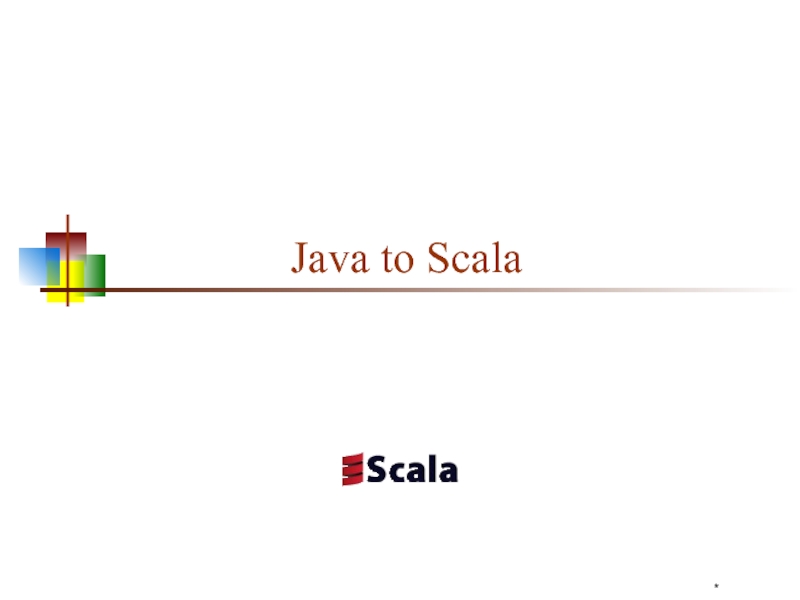
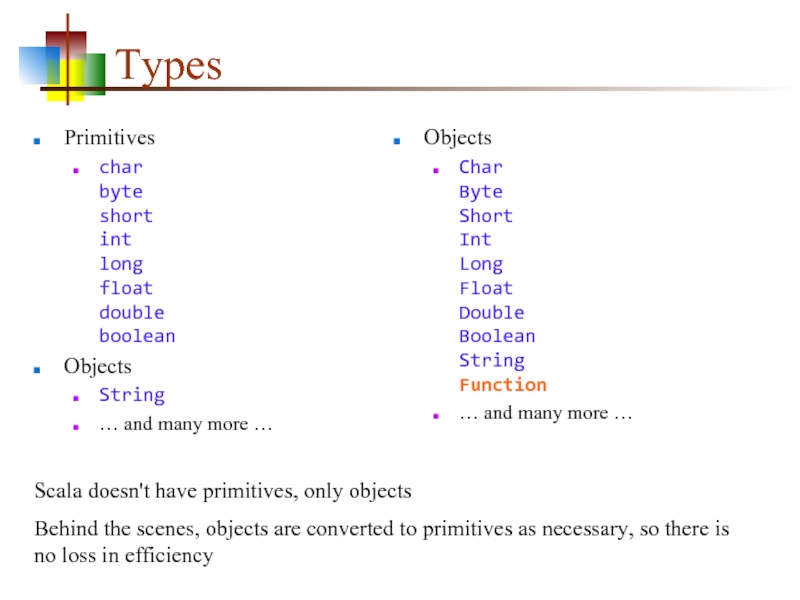
![Type declarationsint x;final int Y = 0;int[] langs = {](/img/tmb/2/144220/a94563acf0663ca6e5b38373b41e9272-800x.jpg)
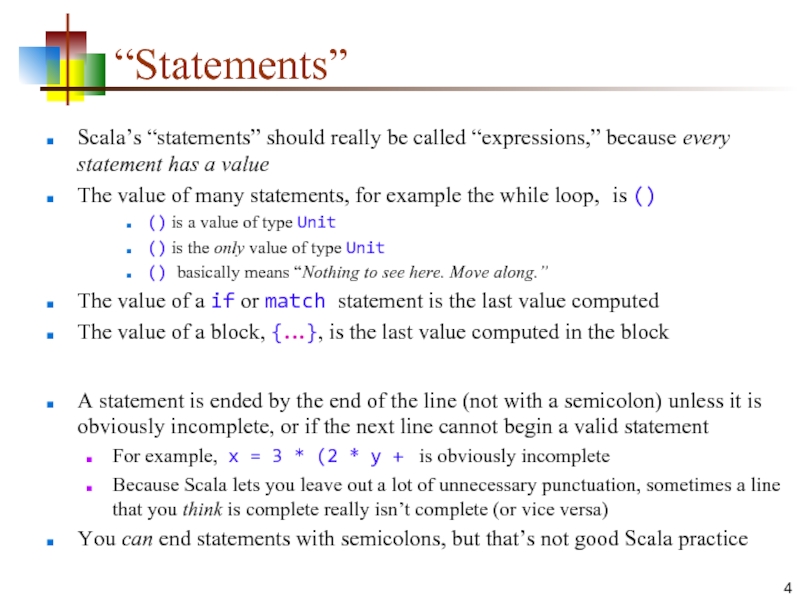
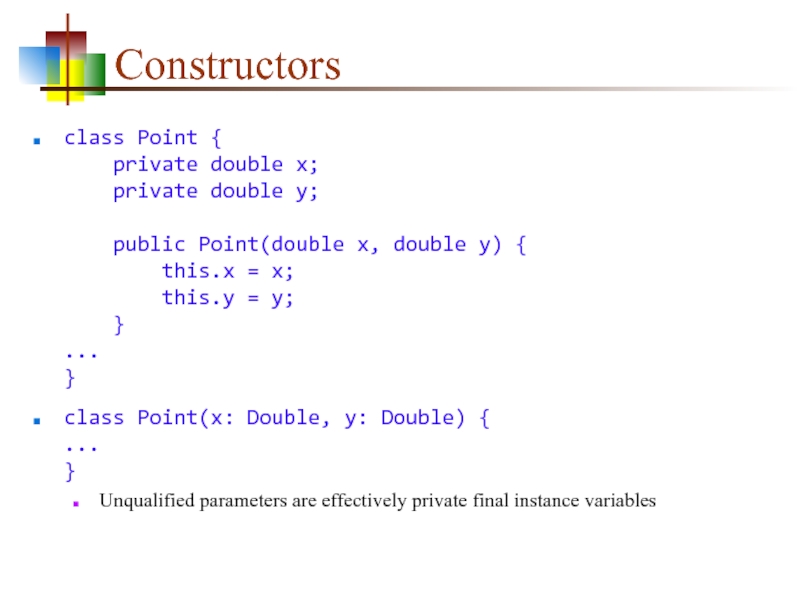
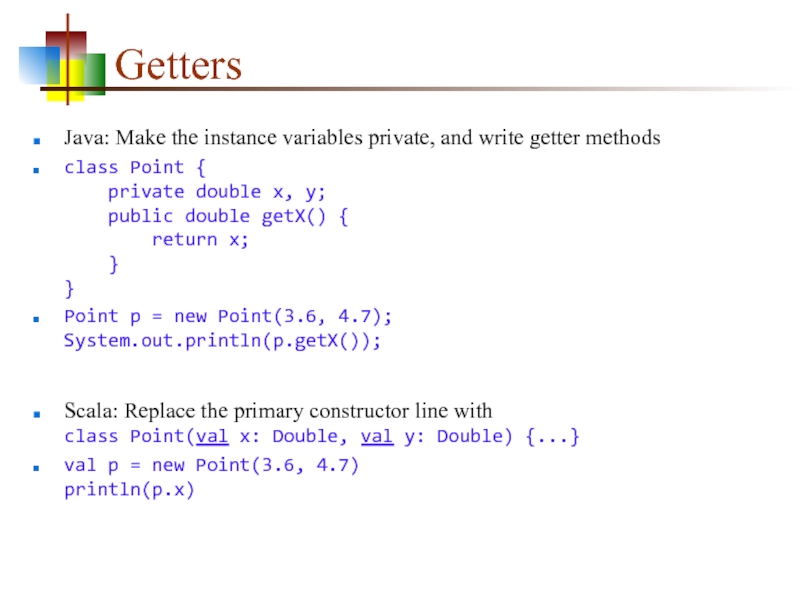
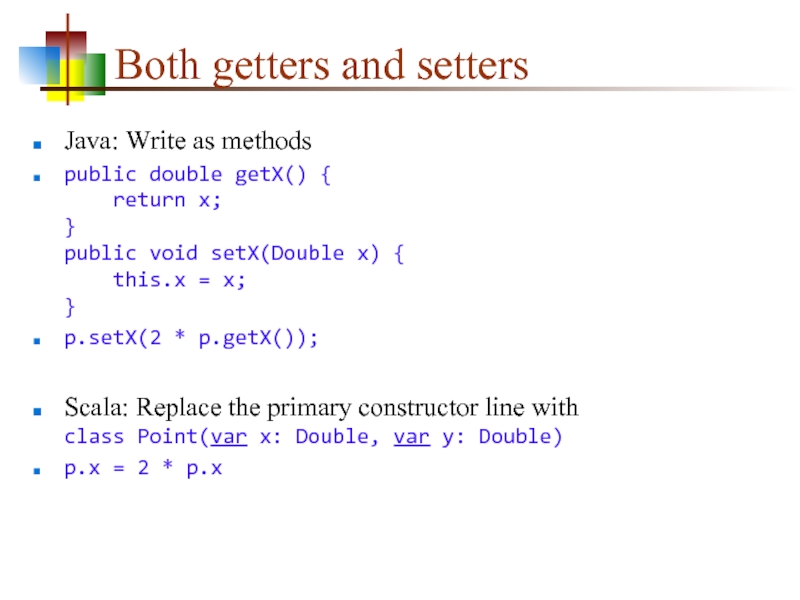
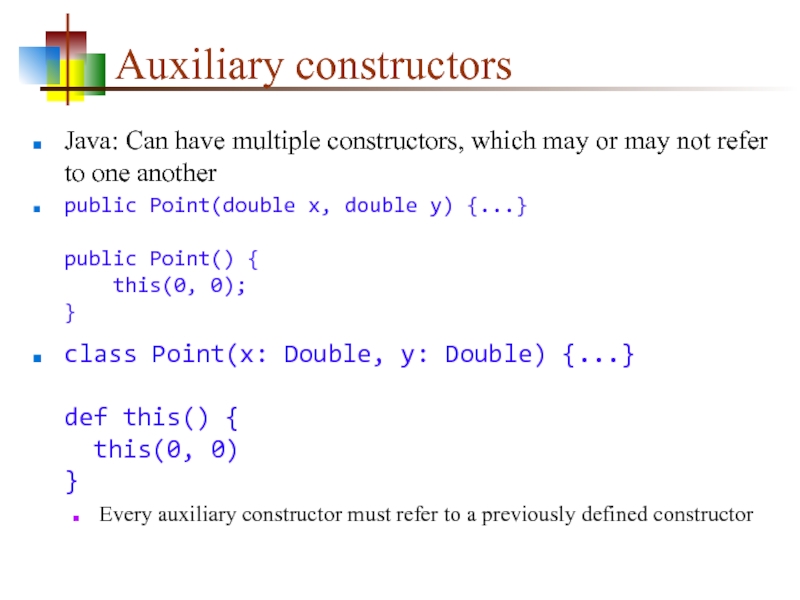
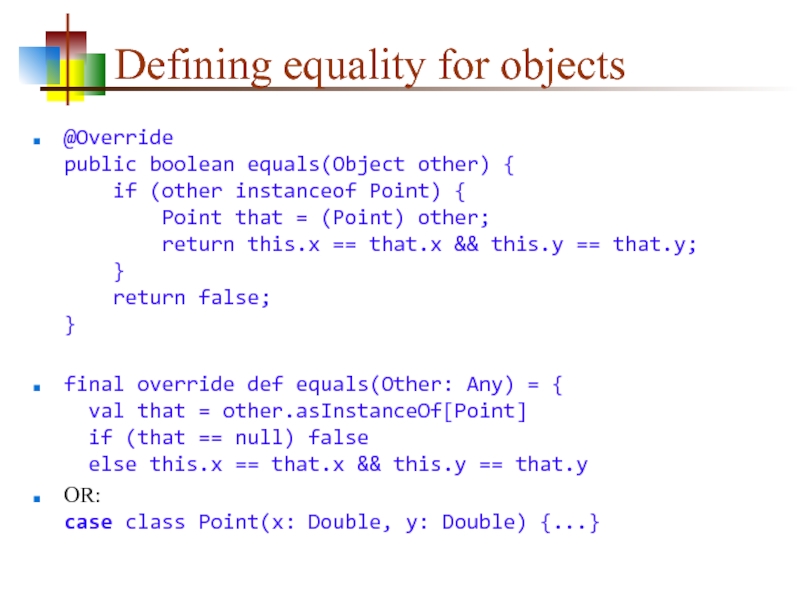
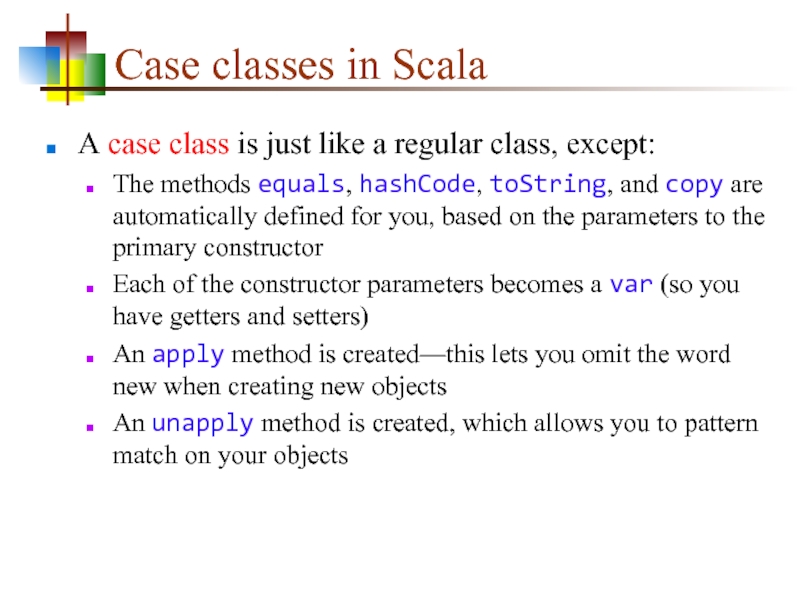
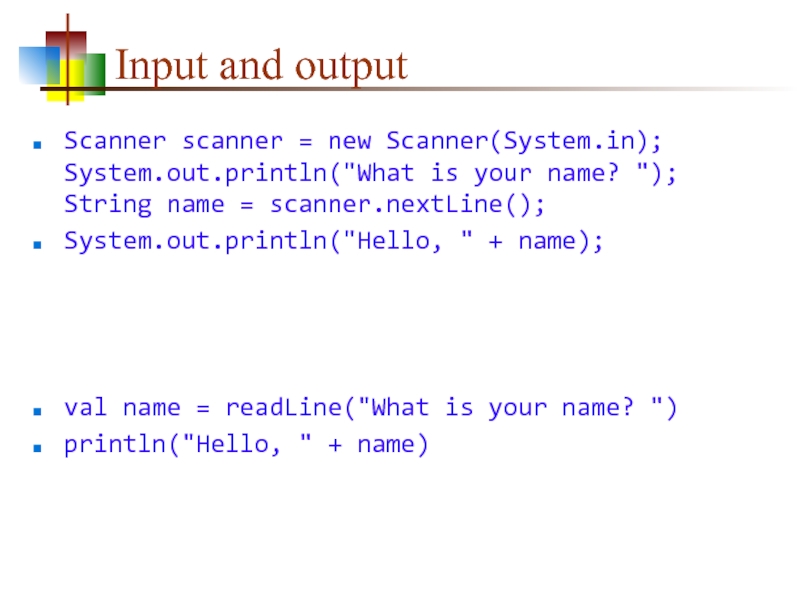
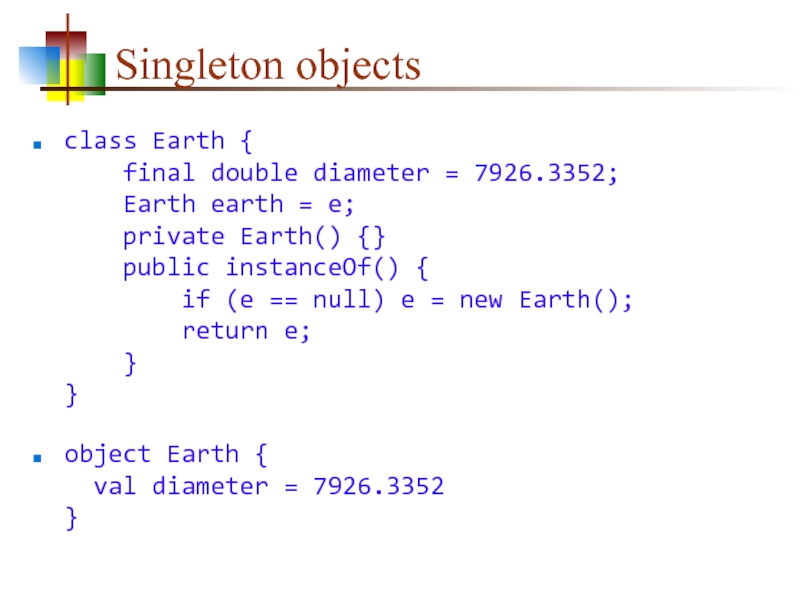
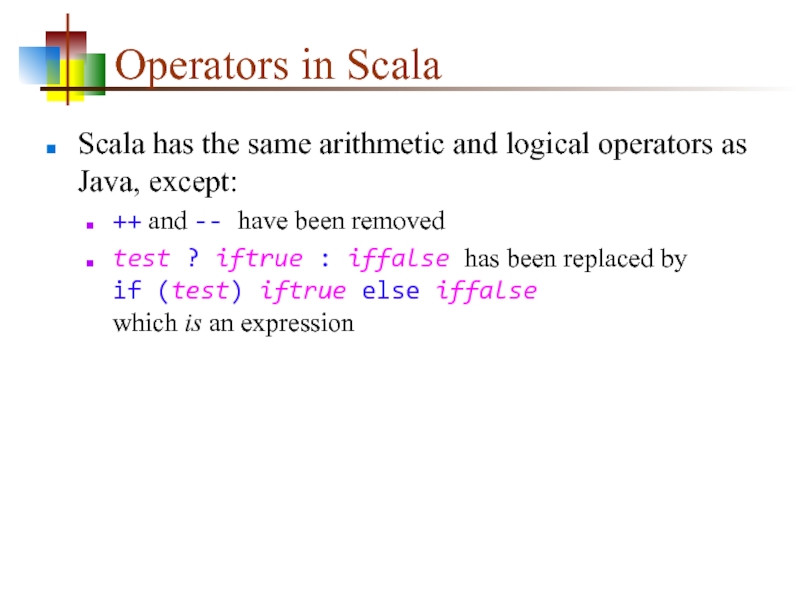
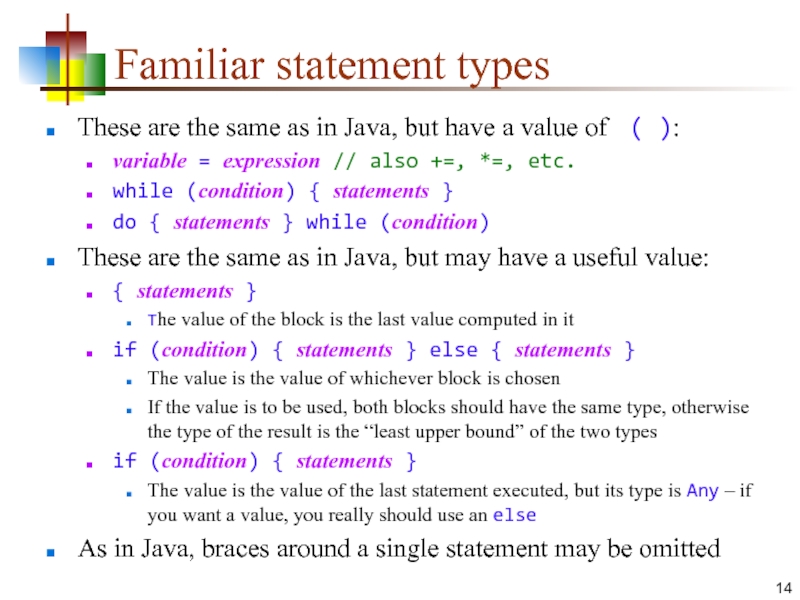
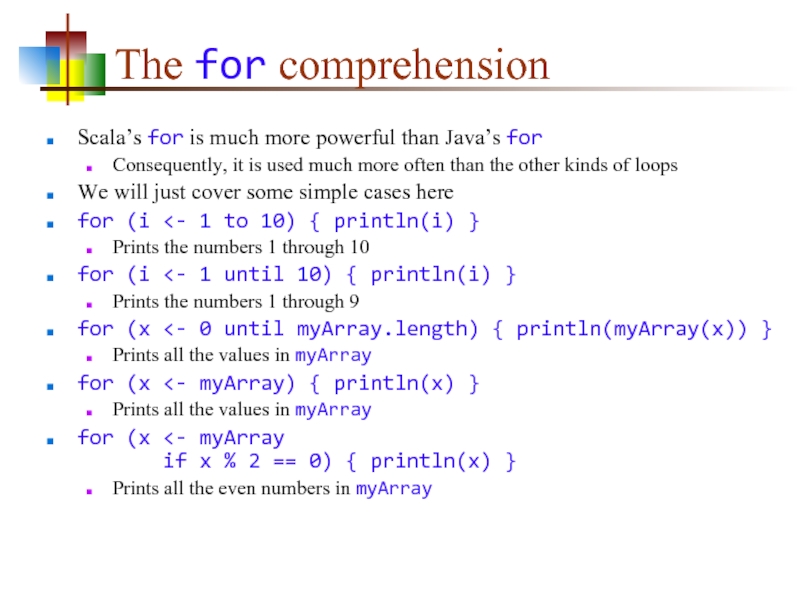
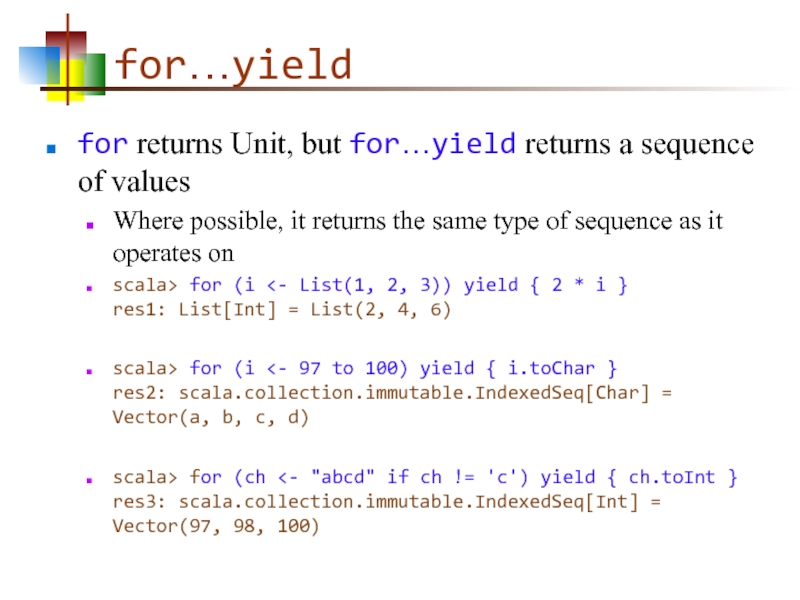

 println("Party! Party! Party!")" alt="">
println("Party! Party! Party!")" alt="">